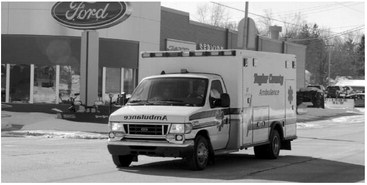No easy road ahead for ambulance coverage


A decades-long relationship to provide ambulance service to county residents is teetering on a knife’s edge over ongoing dissatisfaction with coverage in rural areas and spiraling labor costs.
Taylor County stands at a crossroads when it comes to how to provide emergency medical services. Down one path there are those on the county board who would like to see the county take over complete operation of the service. Others point out that state law puts the obligation to provide ambulance services on the municipalities and that the county does not have a horse in that race. Between the two extremes, there are others who seek to continue some level of the status quo while working to stem the hemorrhaging flow of costs to county taxpayers.
Taylor County must proceed with caution and with the input of the entire county board and residents to determine what, if any changes, should be made to how ambulance services are provided.
There are things we all take for granted in a modern society.
When you turn on a faucet, you expect clean water to come out.
When you flush a toilet, you expect the waste to go down the drain.
When you call for help in a medical emergency, you expect someone to swiftly respond.
These are not extraordinary expectations. They are considered standard throughout the industrialized world, to the point where not having any of them is seen as a symptom of a significant breakdown.
Taylor County is on the verge of a breakdown when it comes to how, and at what cost, emergency medical services (EMS) are provided to residents and visitors.
For decades, the county has partnered with the local hospital in Medford to provide EMS coverage. The county owns the ambulances and equipment and the hospital provides the staff, as well as handling the billing and regulatory compliance. Ambulance crews historically were made up of on-call emergency medical technicians (EMTs), who would leave their workplaces, give up their nights, weekends and time with their own families to respond to emergency calls.
For many years the system worked, with county taxpayers providing an annual subsidy to cover the shortfall in operational revenues.
Things began going downhill in recent years as the number of on-call EMTs dropped. The drop in those willing to answer calls is not unique to Taylor County. It has been felt in communities across the country and seen in service organizations, volunteer fire departments and local government. The influx of new blood has failed to match losses due to people aging.
In place of on-call EMTs, the ambulance service has had to rely on full-time staff members to cover shifts. The COVID-19 pandemic and additional restrictions imposed by the federal government was the tipping point for many of the remaining old guard on-call EMTs to give it up.
Compounding these issues, there have been changes in hospital management and ownership away from the local community- owned model to a regional and more corporate model. There has also been change at the county board level with the addition of board members openly critical of Aspirus’ decisions and actions with the reorganization and staffing of the county ambulance service.
The multi-million-dollar question is where do we go from here?
County finance director Larry Brandl projects that it would cost local taxpayers at least $2 million a year for the county to entirely run the ambulance service above whatever offsetting revenues could come in. Even this may be a conservative amount given the cost of liability insurance, the length of time it takes for federal Medicaid and Medicare reimbursements and the additional wages and benefits not to mention billing infrastructure needed. For those doing the math, this option would result in about a 15% increase in the county tax rate. In this there is also a question of fairness with the bulk of the county’s tax base around the city of Medford while the pressing call for increased local ambulance service is in more rural areas.
Things are not any rosier on the other side. While state law clearly puts the responsibility of guaranteeing emergency medical services onto towns, cities and villages, that is not how it has worked in Taylor County.There is no infrastructure in place to pick up the task if the county were to simply drop it in the municipalities’ laps.
Some border towns would need to turn to neighboring fire departments to contract for coverage, much like Maplehurst and Lublin have had to do for fire protection since the Lublin Fire Department disbanded due to lack of personnel. Others would have to invent new services, making costly investments in equipment and staff or attempt to negotiate their own agreements with Aspirus.
While helping with the county’s bottom line, this option would simply shift the cost to the municipal budgets and do absolutely nothing to address the coverage issues. It would be up to Gilman, Aurora or Rib Lake to pay for additional coverage if those communities wanted additional coverage, if that is even possible. Those neighboring communities are already spread thin with their existing coverage areas. This would also result in major confusion with a hodgepodge of agencies and confusion about who should be dispatched when a call comes in, resulting in duplication, delays and additional costs.
The middle-ground of attempting to negotiate with Aspirus to increase coverage has its own challenges with earned distrust on both sides of the table. For generations the strength of the current model has been that it has been a true partnership with both the hospital and the county working for the good of local residents. That relationship has soured with interactions more often becoming adversarial and accusatory than cooperative. For any real negotiation to take place, both sides must be willing to work together to compromise for actual real-world solutions.
All residents and visitors benefit from a strong and vibrant ambulance service. It is a service that is vital and necessary for the public good. The current model has served the community well for generations. However, that does not mean there are not better, or at least different ways, to reach the same goal.
There are no easy solutions when it comes to ensuring adequate ambulance service coverage throughout Taylor County. The only thing that is clear is that with any decision impacting the entire county, it should be the entire county making that decision and not just a handful on one committee or another.




